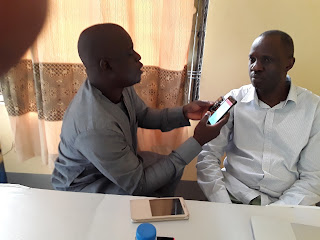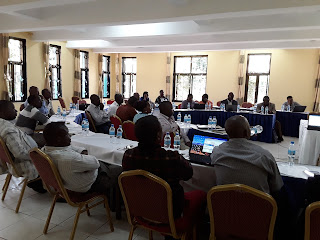By Temitope Musowo
According to Word Economic Forum 2016,Agriculture is a major source of revenue for the Tanzania government, contributing more than a quarter of the country's GDP, employing up to 80% of the workforce, and providing 85 % of the country's exports.
After Tourism, Agriculture is another area of priority of the Tanzanian government,a sector that is enjoying the support both local and international organisations.
Marketing Infrastructure Value Addition and Rural Finance (MIVARF,though a programme of the Tanzanian government, is one of such organisations designed to promote the development of agriculture in Tanzania.
MIVARF programme as being funded by foreign partners like IFAD,ADB, started about seven years ago,though, supposedly ended last year December,has been extended for another two years,hence,the need for MIVIRF to bring together all stakeholders through a capacity building programme to do a review of the programme and chat a way forward for sustainability.
The essence of the stakeholders workshop which was concluded recently was to ensure that all parties involved in the agricultural value chain across the country are well linked together, established for a sustainable mutual operation even long after the foreign partners are out of the programme.
According to Mr Leonard Muhoni, an Agri-business and Marketing specialist with MIVARF ,handling the Producer Empowerment and Marketing linkage component. Who spoke with Devcom Nigeria at the Nyakahoja Conference Centre,venue of the workshop in Mwanza,Mwanza Region of Tanzania, he said, "It is a stakeholders workshop which is more or less like an orientation workshop, following the extension of the programme for two years which ordinarily ended in December last year,so we gather all stakeholders together to chat the way forward in terms of orientation on how to implement the programme towards the end.
These includes officials from the Local Government Authorities, implementing agencies,Service Providers,private companies who are taking the capacity building to the smallholder producers,we also have officials from the regional offices, those who are dealing with the cooperative issues ,they are all represented here, we have representatives from the financial institutions who are also partner in the programme " Muhoni said.
Speaking about the approach being used to achieve result, he added, "Today we are looking at the consortium approach. This consortium approach is more of a trading platform where we have buyers or potential buyers who are not sure of where to get the produce,let's take paddy as an example, we have buyers and processors dealing in a large scale who find it it difficult to get their raw materials, in the other hand ,we have the smallholder producers who have difficulties understanding what the market is ,so,the programme is an ideal of having a platform where partners in this value chain come together, the sellers of farm inputs,financial service providers and the off takers,all meet together to trade ,whatever weakness any of the groups have within their enclave,take for instance, the smallholder farmer groups who are organised under Agricultural Marketing Cooperative Society, AMCOS or SACOS come up with their needs with the buyers at the platform level".
He also noted that they usually have their similar workshop quarterly, where they meet with various stakeholders to have a review of their activities, how well they are achieving their set objectives.
Mr Muhoni enjoyed the participants to note that they had come to the end of the programme, now that the programme had been extended for another two years,they had to do things differently and also consolidate on what they have achieved before in their various programmes especially Marketing Infrastructure, Value Addition and Rural Financing.
"We are consolidating on all these and we are doing it through the consortium approach, then we are reviewing some areas,for example, we change the number of service providers we were working with and they will be working hand in hand with others and their specific activities which they will have to and they will have to understand what the marketing requirements for the season is,so they just have to work together.
We have done quite a lot, so, basically, we are consolidating on what has been done. There have been construction of roads,construction of other facilities, capacity building for the smallholder producers, a lot has been achieved so we are consolidating on all these",Muhoni reiterated.
Speaking with Devcom Nigeria also, one of the participants, a service provider, from the Sengerema District, facilitating linking farmers to the market through consortium model,Mr. James Wembe , who also explained the consortium approach as a platform through which the Lead Firms,the big Buyers plan with the farmers in advance the amount required based on market specification in terms of quantity,quality and frequency as well as mode of delivery.
'''They plan together base on the market need,then farmers start producing to meet the market requirements unlike in the traditional way where farmers produce without market specification, but base on this consortium model, the plan start with the market,both farmers and buyer dialogue through what we call pre season meeting and find the market need,by this we mean the produce market,the farm produce market which will enable the farmers know the farm input require, maybe ,fertilizer, improved seeds. The quantity and variety as demanded by the buyer in advance base on market specification ,then the financial requirements and how to link them to the financial market. So, this things are interconnected, they work in a collaborative way and through the consortium model which is a businesses collaborative meeting, all stakeholders come together to take advantage of the business opportunity",explained Mr Wembe.
He stated further that before the introduction of the approach ,traditionally, people were struggling to improve productivity but through the consortium approach challenges faced by farmers on market including storage,transport and so on are taken care of.
''Market requirement determines the production pattern, how much the buyer will need from the financial institutions and the financial institutions become a part of the model because this is business for everyone, so this is different from the traditional way where farmers were at the center but here market is at the center of everything.
The model according to Mr James reduces cost for all stakeholders, the farmers, the buyers,input suppliers,financial institutions and so on,instead of going around to meet individual which incurs more cost in terms of overhead, this is reduced because the consortium model brings everybody together''.
Talking about significance of the workshop, he said the programme afforded them the opportunity of profiling all potential stakeholders, the off takers,AMCOS,,input providers in their areas,who and who are into what,what are the challenge, how can they work together, what assistance is needed from them,do they need capacity building, what role will the government play and so on.
''So the participants are going with this action plan,so when we have all this information it will help all stakeholders to be well equipped to take advantage of business opportunity even outside their region because they have information about other regions as well'',he maintained.
He explained further on the sustainability of the model that there was contractual agreement between producers and buyers as they usually sign memorandum of understanding, so also between farmers and financial institutions, between farmers and input suppliers as well,AMCOS stands in for the farmers as a body under which farmer producer groups come together
"Another form of checks is the collective marketing,nobody sells outside of the consortium arrangement ,when their produce come in after harvesting, the AMCOS ensure that the loan obtained from the financial institutions is refunded, all the payments pass through the account and deductions are made directly before the farmers get their balance.
In case of defaults the measure put in place for recovery is insurance not just for defaults alone but if anything goes wrong in a particular planting season,then we also have the government as a regulatory body",Wembe concluded.
The participants were asked to profile potential stakeholders in their areas during a brake out session as different speakers took turn to make their presentation with emphasis on the consortium approach.
Various stakeholders from different regions in the country turned out for the workshop which lasted for weeks.



































